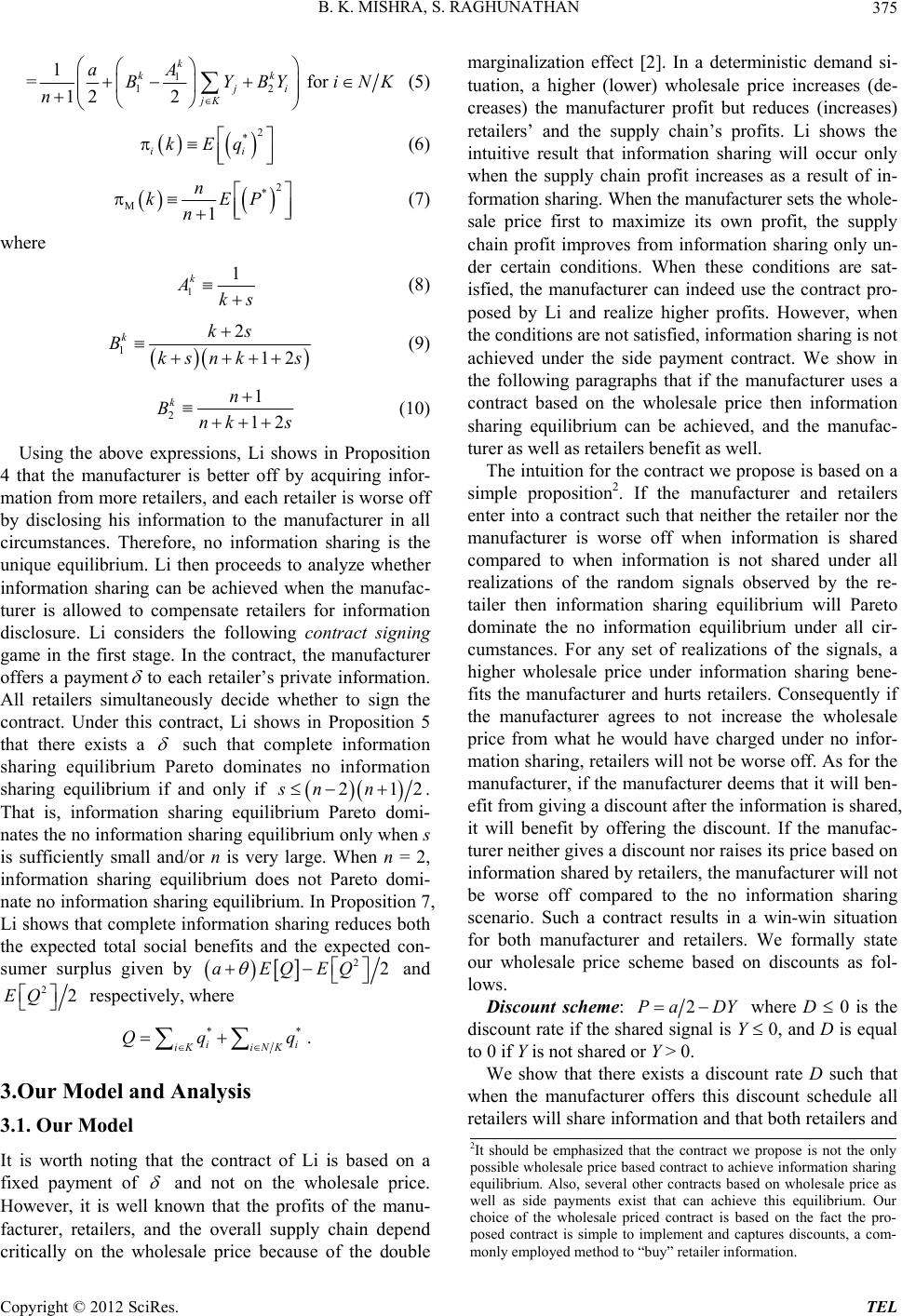
B. K. MISHRA, S. RAGHUNATHAN 375
1
12
1
=
12 2
k
kk
ji
jK
A
aBYBYi
n
f
or
NK
i
(5)
2
*
i
kEq
(6)
2
*
M1
n
kEP
n
(7)
where
1
1
k
Aks
(8)
1
2
12
kks
Bksnks
(9)
2
1
12
kn
Bnk s
(10)
Using the above expressions, Li shows in Proposition
4 that the manufacturer is better off by acquiring infor-
mation from more retailers, and each retailer is worse off
by disclosing his information to the manufacturer in all
circumstances. Therefore, no information sharing is the
unique equilibrium. Li then proceeds to analyze whether
information sharing can be achieved when the manufac-
turer is allowed to compensate retailers for information
disclosure. Li considers the following contract signing
game in the first stage. In the contract, the manufacturer
offers a payment
to each retailer’s private information.
All retailers simultaneously decide whether to sign the
contract. Under this contract, Li shows in Proposition 5
that there exists a
such that complete information
sharing equilibrium Pareto dominates no information
sharing equilibrium if and only if
21sn n 2.
That is, information sharing equilibrium Pareto domi-
nates the no information sharing equilibrium only when s
is sufficiently small and/or n is very large. When n = 2,
information sharing equilibrium does not Pareto domi-
nate no information sharing equilibrium. In Proposition 7,
Li shows that complete information sharing reduces both
the expected total social benefits and the expected con-
sumer surplus given by
22aEQEQ
and
22EQ
respectively, where
**
ii
iK iNK
Qq
q.
3.Our Model and Analysis
3.1. Our Model
It is worth noting that the contract of Li is based on a
fixed payment of
and not on the wholesale price.
However, it is well known that the profits of the manu-
facturer, retailers, and the overall supply chain depend
critically on the wholesale price because of the double
marginalization effect [2]. In a deterministic demand si-
tuation, a higher (lower) wholesale price increases (de-
creases) the manufacturer profit but reduces (increases)
retailers’ and the supply chain’s profits. Li shows the
intuitive result that information sharing will occur only
when the supply chain profit increases as a result of in-
formation sharing. When the manufacturer sets the whole-
sale price first to maximize its own profit, the supply
chain profit improves from information sharing only un-
der certain conditions. When these conditions are sat-
isfied, the manufacturer can indeed use the contract pro-
posed by Li and realize higher profits. However, when
the conditions are not satisfied, information sharing is not
achieved under the side payment contract. We show in
the following paragraphs that if the manufacturer uses a
contract based on the wholesale price then information
sharing equilibrium can be achieved, and the manufac-
turer as well as retailers benefit as well.
The intuition for the contract we propose is based on a
simple proposition2. If the manufacturer and retailers
enter into a contract such that neither the retailer nor the
manufacturer is worse off when information is shared
compared to when information is not shared under all
realizations of the random signals observed by the re-
tailer then information sharing equilibrium will Pareto
dominate the no information equilibrium under all cir-
cumstances. For any set of realizations of the signals, a
higher wholesale price under information sharing bene-
fits the manufacturer and hurts retailers. Consequently if
the manufacturer agrees to not increase the wholesale
price from what he would have charged under no infor-
mation sharing, retailers will not be worse off. As for the
manufacturer, if the manufacturer deems that it will ben-
efit from giving a discount after the information is shared,
it will benefit by offering the discount. If the manufac-
turer neither gives a discount nor raises its price based on
information shared by retailers, the manufacturer will not
be worse off compared to the no information sharing
scenario. Such a contract results in a win-win situation
for both manufacturer and retailers. We formally state
our wholesale price scheme based on discounts as fol-
lows.
Discount scheme: 2Pa DY
where D 0 is the
discount rate if the shared signal is Y 0, and D is equal
to 0 if Y is not shared or Y > 0.
We show that there exists a discount rate D such that
when the manufacturer offers this discount schedule all
retailers will share information and that both retailers and
2It should be emphasized that the contract we propose is not the only
ossible wholesale price based contract to achieve information sharing
equilibrium. Also, several other contracts based on wholesale price as
well as side payments exist that can achieve this equilibrium. Our
choice of the wholesale priced contract is based on the fact the pro-
osed contract is simple to implement and captures discounts, a com-
monly employed method to “buy” retailer information.
Copyright © 2012 SciRes. TEL